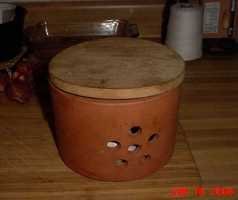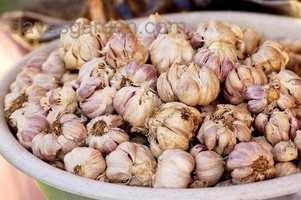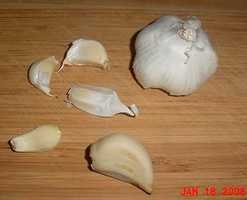





Garlic has been used throughout recorded history for both culinary and medicinal purposes. It has a characteristic pungent, spicy flavor that mellows and sweetens considerably with cooking. Due to its strong odor, garlic is often called ?The Stinking Rose?.
Allium sativum, commonly known as garlic, is a species in the onion family Alliaceae. Its close relatives include the onion, the shallot, and the leek.
Whole garlic bulbs are grown underground and contain individual sections called cloves. The individual cloves may be planted to produce more bulbs or they may be eaten raw and cooked. The stems (scapes) and leaves are also edible with a milder taste.
Much folklore surrounds this ancient plant. Garlic may or may not repel vampires, but if you eat enough of it, you could be less tasty to mosquitoes. And as my uncle used to say, “A dime will get you a ticket on the subway but garlic gets you a seat.”
Garlic planted close to roses and fruit trees is said to repel pests. Growing Garlic is easy!
Growing Garlic is easy!
One of the easiest plants for the home garden, garlic is hardy in USDA Zones 3a-8b. If you have full sun, good drainage and pH in the neutral range, you can grow garlic! Although you could plant sprouting bulbs from your kitchen, catalogs offer a vast array of garlic varieties to try. Garlic is planted in the fall and harvested the following summer.
There are over 600 of varieties of garlic although I have never seen a complete list. Basically garlic has 2 varieties, softnecks (var. sativum) and hardneck (var. ophioscorodon). Different varieties and their subspecies like Creole Garlic, Porcelain, Rocambole, Artichoke, Silverskin are grown and stored differently in the south vs. the north.[1] Future articles on hardneck, softneck and lesser known garlics will include all you need to know to grow these different varieties.
Elephant Garlic, Allium ampeloprasum, is not a garlic but closely related to leeks rather than true garlic. Humans, ground squirrels, voles, and gophers like this mild “garlic”.
Garlic is harvested in summer when the tops begin to turn brown. Store garlic warm (above 64ºF but not hot) and dry, and in the dark to keep it dormant.
Culinary Uses
Garlic is widely used around the world for its pungent flavor as a seasoning or condiment. Different garlic cultivars have different levels of heat and flavor, but the method of preparation also influences flavor. Whole and roasted, poached or stewed cloves have a milder flavor. Processing or mincing releases more oil and produces the strongest flavor. Cooking garlic makes it sweeter and milder, and roasting produces a "complex, nutty, caramelized" flavor.
Garlic’s papery skin is like the skin of an onion, and is typically removed before using. It is often paired with onion, tomato, or ginger. Try a few scapes (stems) chopped on a fresh garden salad. They are often used in stir fries mixed with fresh ginger. Garlic leaves are popular in many parts of Asia. The leaves are cut, cleaned and then stir-fried with eggs, meat, or vegetables.
Garlic is essential to several Mediterranean dishes. Mixing garlic with eggs and olive oil produces aioli ("garlic and oil") in Provençal. The Spanish garlic and oil mixture does not use eggs.[1] Oils can be flavored with fresh garlic. Commercially prepared oils are widely available, but preparing garlic oil at home is a risk. You can keep it safely only if refrigerated and used within one week. [4]
Slow roasting causes garlic to lose most of its heat and turn nutty and sweet, with a pleasant mild garlic flavor. Roasted garlic is wonderful in soups, vinaigrettes, and sauces, and makes the best mashed potatoes. It can be combined with cream to make a delicious sauce for vegetables, pasta and fish. Try smearing it onto toasted French bread, along with a little of its roasting oil and a thin slice of Stilton cheese.
To roast garlic, cut the top off the bulb and dribble some olive oil over it, coating all the cloves well. Add some fresh thyme (optional), put the top back on, cover with foil and roast in the oven at 400ºF for 25-35 minutes until soft. I usually roast a few heads at a time, since I use it quite liberally. Leftover cloves can be squeezed from their skins into a small dish and covered with olive oil. Store tightly covered in the refrigerator for a few days.[3]
Whenever possible use fresh garlic rather than commercially processed powders, cloves and granules. The flavor of fresh garlic is far superior to dehydrated versions. Garlic powder may contain less than 20% actual garlic due to the addition of large amounts of salt and anti-caking agents.  Medicinal Uses
Medicinal Uses
Garlic's uses in folk medicine include treatments for bronchitis and respiratory problems, gastrointestinal problems, flatulence, leprosy, menstrual cramps, high blood pressure and diabetes. External application is said to treat warts, corns, arthritis, muscle pain, neuralgia and sciatica. It's no wonder that garlic acquired the name poor man's cure-all.
In Ayurvedic medicine garlic is considered heating, diuretic, diaphoretic (induces sweating), expectorant, carminative, anti-coagulant, anthelmintic (rids the body of intestinal worms) and immune enhancing.
Homeopathically, garlic is used to treat upper respiratory tract inflammation, rheumatism and digestive problems.
Louis Pasteur first verified garlic's antibacterial properties scientifically in 1858. During WWI, garlic juice, water and sphagnum moss were used to bandage wounds. It was also used in WWII to prevent septic poisoning and gangrene. Even before Pasteur's discovery, garlic was a recorded military disinfectant, and poultices of moss, garlic and wine were used to treat soldiers in the army of Ancient Rome.
Recently, science has begun to confirm many of garlic's other long-standing medicinal uses. Garlic has been shown to lower blood cholesterol, blood pressure and blood sugar in laboratory studies and clinical trials. Garlic has also demonstrated anti-cancer, antibacterial, anti-fungal and anti-oxidant effects.[5]
Whether you view it as a wonder drug or a culinary delight, consider growing garlic in your garden.
FOOTNOTES
[1] http://www.garlicfarm.ca/garlic-varieties.htm
[2] http://en.wikipedia.org/wiki/Garlic
[3] Susan Belsinger, http://herbsociety.org/garlic/grecipe01.php
[4] http://www.hc-sc.gc.ca/iyh-vsv/food-aliment/garlic-ail_e.html
[5] http://www.herbsociety.org/garlic/gmeduse.php
Thanks to Chamma and Kmom246 for photos from Plantfiles.
Tomato, Bread and Garlic Soup
In Italy this wholesome peasant style soup is called Pappa al Pomodoro. Its porridge-like consistency looks rather strange to Americans and it depends a lot on the type of bread used. A simple country loaf that has a crunchy crust is good, as is whole wheat sourdough. Breads made with all white flour will make this recipe gummy.
This soup may be served hot or cold. We like it straight from the pot after it has sat for an hour… just soothingly warm. Simple to make and delicious to eat, this dish can make a satisfying meal with a glass of red wine and a salad.
8 garlic cloves
1 small dried red chili pepper
¾ cup extra-virgin olive oil
2 1/2 pounds ripe tomatoes, peeled and chopped (in winter I use Muir Glen canned tomatoes)
3 Tbs. shredded fresh basil leaves OR 2 tsp. dried
1 Tbs. shredded mint leaves
Salt and freshly ground pepper
4 cups hot chicken or vegetable stock
1 pound of 1-2 day old crusty bread
Freshly grated Parmesan cheese
Pound the peeled garlic cloves and the dried chili in a mortar and pestle until they are well crushed. Heat the olive oil in a large non-corrosive sauté pan or soup pot over low heat. Add the garlic and chili and soften over low heat for about 3-4 minutes.
Add the tomatoes, basil and mint; stir and cook over medium-low heat for about 5 minutes. Season with salt and pepper to taste and cook for another minute or two. Add the stock and bring to a boil. While the stock is heating, tear the bread into bite-sized cubes. When the stock comes to a boil, add the bread all at once. Stir well over medium heat until all the bread is moistened with the liquid.
Cover pan and remove from heat. Let soup stand for an hour before serving but taste again for seasoning and stir well. Serve in bowls with a little olive oil. Garnish with freshly grated Parmesan.
(A yummy old recipe I've had for years taken from The Garlic Book, Copyright by Susan Belsinger and Carolyn Dille)
Copyright © www.100flowers.win Botanic Garden All Rights Reserved